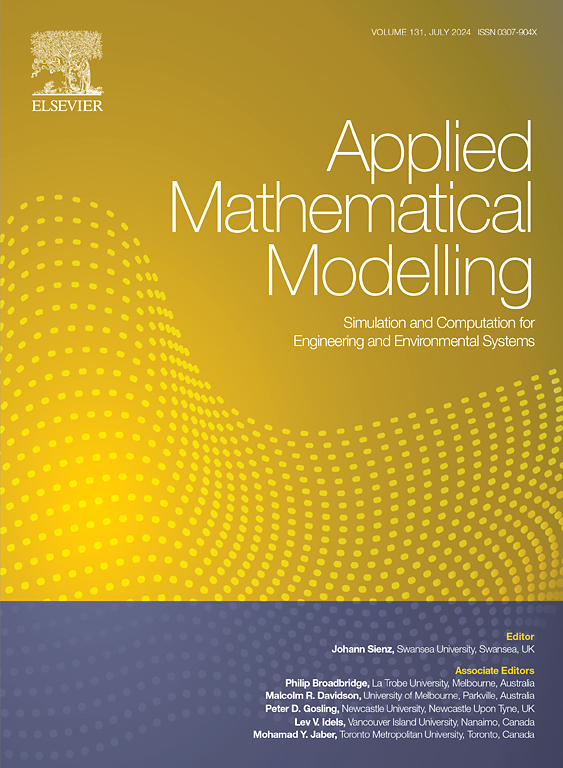Flexoelectronics of a centrosymmetric semiconductor cylindrical nanoshell
IF 4.4
2区 工程技术
Q1 ENGINEERING, MULTIDISCIPLINARY
引用次数: 0
Abstract
Cylindrical shell-type semiconductors are essential for sensing and energy harvesting when integrated into surfaces of certain equipment, such as spacecraft, marine devices, and portable electronics, where mechanical forces play a significant impact on charge transport. Traditionally, such functionalities are only manifested in piezoelectric or pyroelectric crystals that possess non-centrosymmetry. Here, we theoretically investigate electronic behaviors driven by strain gradient-induced flexoelectric polarization in a centrosymmetric semiconductor cylindrical nanoshell, expanding the flexoelectronics in shell structures. The governing equations and accompanying boundary conditions are formulated simultaneously using the principle of virtual work and the fundamental lemma of the calculus of variation. Electromechanical interactions through static bending and forced vibration analyses of the newly developed model are systematically investigated. Under localized force excitation, the distribution of mobile charges is manipulated by tuning loading magnitudes and areas. The effects of doping levels on electric potentials and mobile charges are explored to show the interaction mechanism between flexoelectric and semiconducting properties. Moreover, the natural frequencies and modes of all mechanical displacements, electric potentials, and carrier concentration perturbations within the shell are identified. This paper provides a new approach for designing shell-shaped sensors and energy harvesters specifically for centrosymmetric semiconductors.
中心对称半导体圆柱纳米壳的柔性电子学
当某些设备(如航天器、航海设备和便携式电子设备)的表面集成了圆柱壳型半导体时,圆柱壳型半导体对于传感和能量收集至关重要,因为在这些设备中,机械力对电荷传输有重大影响。传统上,只有具有非中心对称性的压电晶体或热释电晶体才能实现这种功能。在此,我们从理论上研究了中心对称半导体圆柱纳米壳中由应变梯度诱导的挠电极化所驱动的电子行为,拓展了壳结构中的挠性电子学。利用虚功原理和变分微积分的基本定理,同时制定了治理方程和相应的边界条件。通过对新开发模型的静态弯曲和强迫振动分析,系统地研究了机电相互作用。在局部力激励下,移动电荷的分布可通过调整负载大小和面积来操控。研究还探讨了掺杂水平对电动势和移动电荷的影响,以显示挠电特性和半导体特性之间的相互作用机制。此外,还确定了外壳内所有机械位移、电动势和载流子浓度扰动的固有频率和模式。本文为专门针对中心对称半导体设计壳形传感器和能量收集器提供了一种新方法。
本文章由计算机程序翻译,如有差异,请以英文原文为准。
求助全文
约1分钟内获得全文
求助全文
来源期刊

Applied Mathematical Modelling
数学-工程:综合
CiteScore
9.80
自引率
8.00%
发文量
508
审稿时长
43 days
期刊介绍:
Applied Mathematical Modelling focuses on research related to the mathematical modelling of engineering and environmental processes, manufacturing, and industrial systems. A significant emerging area of research activity involves multiphysics processes, and contributions in this area are particularly encouraged.
This influential publication covers a wide spectrum of subjects including heat transfer, fluid mechanics, CFD, and transport phenomena; solid mechanics and mechanics of metals; electromagnets and MHD; reliability modelling and system optimization; finite volume, finite element, and boundary element procedures; modelling of inventory, industrial, manufacturing and logistics systems for viable decision making; civil engineering systems and structures; mineral and energy resources; relevant software engineering issues associated with CAD and CAE; and materials and metallurgical engineering.
Applied Mathematical Modelling is primarily interested in papers developing increased insights into real-world problems through novel mathematical modelling, novel applications or a combination of these. Papers employing existing numerical techniques must demonstrate sufficient novelty in the solution of practical problems. Papers on fuzzy logic in decision-making or purely financial mathematics are normally not considered. Research on fractional differential equations, bifurcation, and numerical methods needs to include practical examples. Population dynamics must solve realistic scenarios. Papers in the area of logistics and business modelling should demonstrate meaningful managerial insight. Submissions with no real-world application will not be considered.
 求助内容:
求助内容: 应助结果提醒方式:
应助结果提醒方式:


